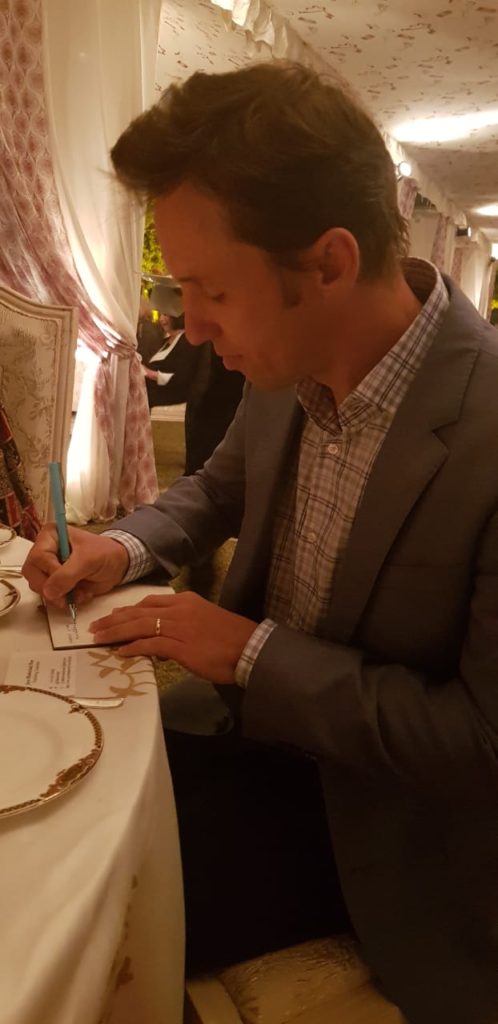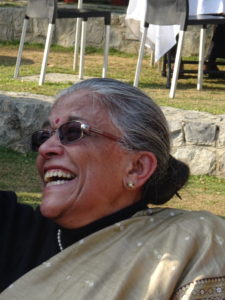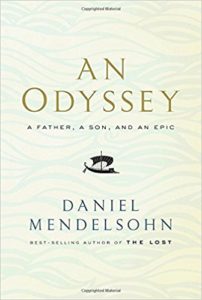Interview with Markus Zusak, author of “Bridge of Clay” and “The Book Thief”
Bridge of Clayby Markus Zusak is an extraordinary book. It is a story about a family of five brothers and their parents. Penelope Lesciuszko, and then Penny Dunbar, the mother is an immigrant who is dearly loved by her second husband, Michael Dunbar, and father of the boys. One fine day it all falls apart with the discovery that the mother has cancer. It is a slow death. A grief so searing that it tears the family apart. The father drifts away, abandoning the boys, expecting them to fend for themselves. It is a story told slowly, flipping back and forth in time, by one of the sons – Michael Dubar. Bridge of Clay is about the Dunbar family, Michael returning to the boys seeking their help to build his dream bridge and the younger son, Clay, offering to help.
Bridge of Clay is quite unlike Markus Zusak’s previous novel, The Book Thief. Yet, Bridge of Clay is a fabulous novel for its craftsmanship, its unique form of storytelling, its pacing, its brilliant unexpectedness. It builds upon expectations of the readers of The Book Thief but as Markus Zusak says in the interview, “the challenge was always to write this book the way it needed to be written, despite The Book Thief’s success, and readers wanting the same experience. And that’s something I know I fought for.”
I met Markus Zusak at the Jaipur Literature Festival where he was a part of the delegation of writers and publishers brought across by the Australian High Commission. It was then he kindly agreed to do an interview for my blog.
Here is an edited version of the interview conducted via email.
****

Picture by: Jaya Bhattacharji Rose
JBR: Bridge of Clay can only be read if one places oneself in that fog which comes with grief and numbness of sorrow. What prompted this story? How do you work out the voices of the characters?
MZ: I had this story in my mind since I was twenty years old…I was walking around my neighbourhood back then, in Sydney, and I had this vision of a boy who was building a bridge and he wanted it to be perfect – one beautiful, perfect, great thing.
The voices of the characters came the way all ideas do – from spending time with the book, getting to know it. After I’d written The Book Thief, I realised it was finally time to take on the boy and his bridge. And as soon as I did that, I thought, ‘Well, you can try to write a smaller, quieter book…or you can bet everything.’ I decided to bet everything, and the first part of that was seeing Clay, the protagonist, as one of five brothers. Next came the multi-generational story, and I took it from there.
JBR: This kind of fluid writing, languid, placid, calming tone of the narrator, all the while creating a disruptive narrative is very emotionally draining to craft. Yet it feels special in Bridge of Clay. Did it take many revisions to achieve? What was your routine to write this book? Did it differ from your other books?
MZ: Routine is everything. I actually have a friend whose first question to me when we meet is, ‘How’s your routine going?’ The idea of the writing in Bridge of Clay was very exact. Matthew is trying to make order of the chaos in the epic, sprawling and sometimes shambolic history of the Dunbar family, and I was trying to write in the spirit of Clay’s bridge-building. I feel like that was one of the reasons it took thirteen years to write this book. I was writing for the world championship of myself.
JBR: Did this book involve research?
MZ: It took a lot of time researching this book – not only bridge building and the artworks of Michelangelo, and horseracing, and details of Eastern Europe during communism, but also the biggest research of all – which is getting to know the characters themselves. Being with the characters and working for them is what gets a book over the line, I think. In the end you’re not writing for the audience anymore – you’re writing for them – the characters inside the book. In this case I was writing for Clay and all the Dunbar boys, and the animals in their household, and for Michael…but especially for Penny Dunbar, who is the true heart of the book.
JBR: Why jumble the sequence of events?
MZ: The structure of this book works in two ways: one is that it continually builds, which is why each part is still titled with the previous part. For example, Part Two is called Cities + Waters, rather than just Waters. Part three is Cities + Waters + Criminals. I did this because it replicated the building of the bridge, but also because we don’t just live things and leave them behind. We carry our stories with us.
The second part of the structure is tidal – where the past and present come back and forth like the tide coming in and going out. I like the idea that we start becoming who we are long before we’re even born. Our parents’ stories are embedded in us, and so are their journeys and sacrifices, their failures and moments of heroism. I wanted to recognize those stories. I wanted to write a book about a boy in search of his greatest story whilst recognizing the stories that got him to that point.
As Clay is makes his way outwards in the world, the history of the Dunbar family is coming in…and I think that’s how our memories work. We are always caught in the current between looking forward and behind us.
JBR: Pall of death looms large. It is not discussed easily in families. Yet a nickname soon takes on a proper noun — “Murderer”, a terrible reminder of Death. Why choose this horrific literary technique?
MZ: Matthew Dunbar names Michael, his father, the Murderer because he left the family after their mother, Penelope, died. He claims that he killed their family by doing this, so it’s really a play on words. I also used it because I think we all know when we see a nickname like that, that there must be more to it. Is he really a murderer? Or is he taking the blame for someone else – and in what capacity has a crime been committed?
We spend this entire novel getting to know its characters (and especially Clay), and when we finally understand the irony of the nickname, we have one of the last pieces to understanding its protagonist.
JBR: Why have such a slow paced novel at a time when every else is writing fast paced detailed novels? Is this novel about the creation of art, creating something unique? How did you decide upon the chapter titles? A piece of artwork that is only completed with the complete engagement of the reader otherwise the story glides past.
MZ: Why follow a trend of continually making this easier, faster, and too easily known? We live in a world now where we feel like we deserve to know everything right now – and I see the role of novels as a saving grace where we can still say, ‘Come on – do some work. Think a little bit. I promise you’ll be rewarded.’ Maybe novels are one of the last frontiers where the pay-offs aren’t instant. You can be offered a whole world, but it also demands your attention. They’re the sort of books that have always become my favourites.
JBR: What came first — the story or the narrator?
MZ: The story was always there. I had several different attempts at narrators, and settled on Matthew about seven years into writing the book…In the end he deserved it – he does so much to keep the Dunbar family together, and he’s telling the story to understand and realise just how much he loves his brother, and how much he wants him to come home.
JBR: How did it feel to create the character of Clay?
MZ: Clay was always there. He was always there, attempting to be great. He kept me honest writing the book. I wrote this book to measure up to him.
JBR: Who is Penelope modelled upon? Why does it seem that she is not necessarily based on her namesake from the epic?
MZ: All characters become completely themselves from the first time you fictionalise something about them. In the case of Penelope, she was based on my parents-in-law, who came to Australia from Poland. When they got here they were shocked by the heat. They’d never seen a cockroach before. They were horrified…but they had made this epic journey to start a new life – and that was the first seed for Penelope’s story – but from the moment I saw her practising the piano and being read to from The Iliad, she was only ever Penelope Lesciuszko, and then Penny Dunbar.
As for not being a based on the exact template of Penelope in The Odyssey, she’s certainly patient, and determined – but I also wanted her to be more. All of the characters in this novel are heroic in their own way. Penelope, as I said, is the heart of the book, and I wanted her to be stoic, and deceptively strong. She’s perennial – a survivor and mother, and certainly a formidable opponent in the Piano Wars with her sons
JBR: Which edition of the Odyssey and Illiad did you read? When did your love for the epic start? What prompted you to reimagine it?
MZ: My editions are the Penguin classics, translated by E.V. Rieu. I never studied them at school or university, but I decided one day that I needed to read The Iliad. I always loved the bigness of them – the larger-than life characters and language…the overwroughtness of it!
As for it’s thread in Bridge of Clay, it came to me when all of the characters started having nicknames, and when Clay is training – the start of the novel is like the Games in Ancient Greece. Then, when I thought of Penelope being called The Mistake Maker, I immediately saw her practising the piano in Eastern Europe, which I called a ‘watery wilderness’, which was a direct quote from Homer’s description of the sea. I thought, ‘Oh, that’s what Bridge of Clay is. It’s a suburban epic that pays tribute to the bigness of our everyday lives.’ We all think we have dull, drab existences, but we all fall in love, We all have people die on us. We all fight for what we want sometimes. It all just seemed to fit, and then I thought of Penelope being sent to Australia with a copy of The Iliad and The Odyssey. I never doubted that part of the story.
JBR: What was it like to interact with readers in India when you visited the country in January?
MZ: To be in India with a book is like being with your fiercest friends. Indian readers are special in that they love showing you how much they love you, and as a reading culture it is like no other place in the world. I loved every minute.
JBR: Why release the book for two types of readers across the world particularly in an important book market like USA where it has been labelled as #yalit?
MZ: I’ll often answer this question by saying it really doesn’t matter because a book will find its true audience. I had a choice to release this book with a different publisher to place it firmly in adult territory, but I love the people I work with, and I wanted to stay with them. That’s the only reason it was released as a young adult novel there. I think that was possibly an easier proposition with The Book Thief, because it’s an easy book to love – but I think Bridge of Clay does makegreater demands of its reader. It’s a tougher book to read. Liesel is given to you on a plate; she’s easy to love – orphaned, in a book about loving books – but Clay is a character to fight for. You almost have to prove that you can withstand all he goes through to fully understand him.
In short, a reader almost has to earn the right to love him – and so maybe it’s more a novel for true believers in my writing, which makes it a harder book to market for teenagers.
Either way, the challenge was always to write this book the way it needed to be written, despite The Book Thief’s success, and readers wanting the same experience. And that’s something I know I fought for. Every decision was made to make the book exactly what it needed to be, and follow its vision completely.
28 March 2019




